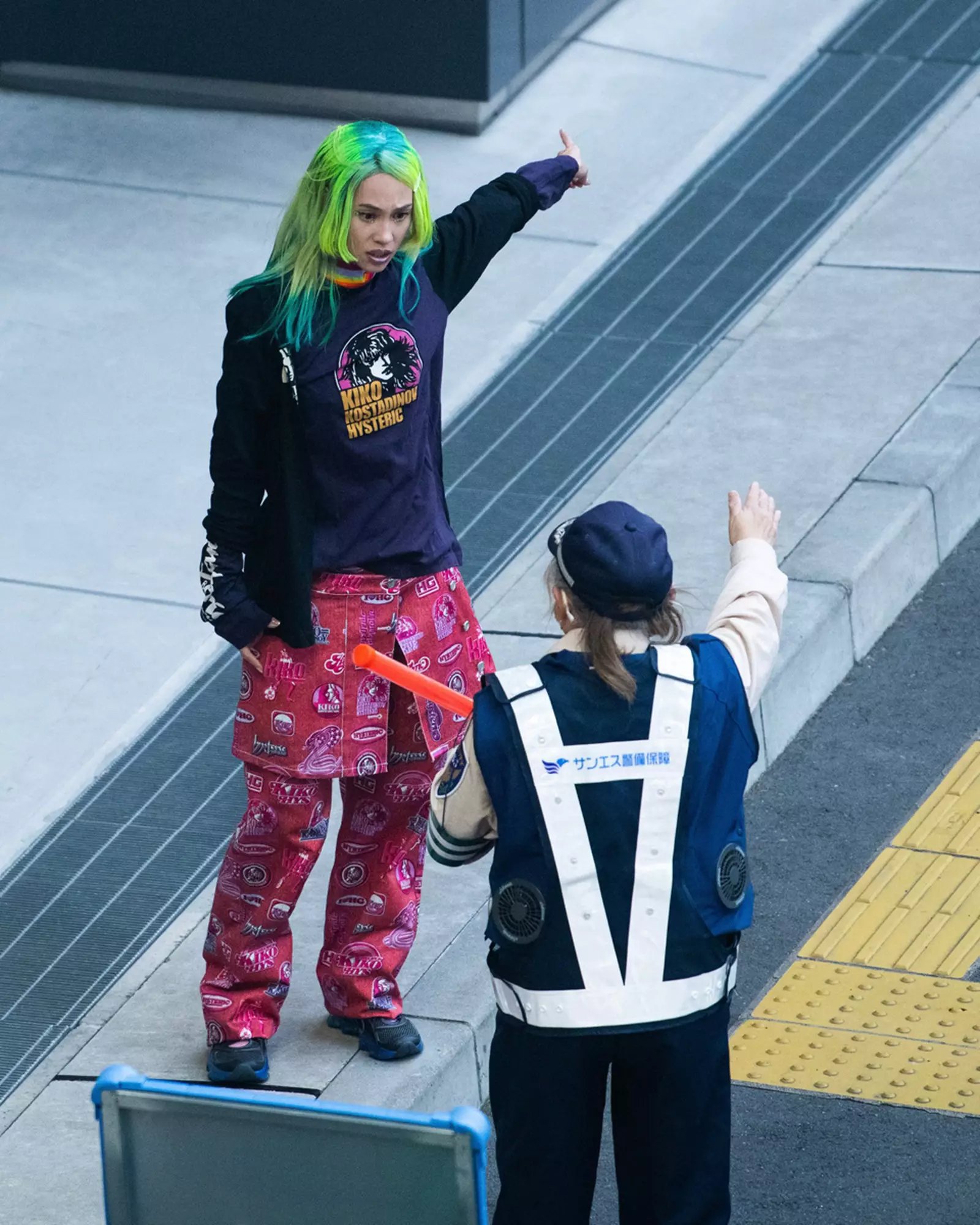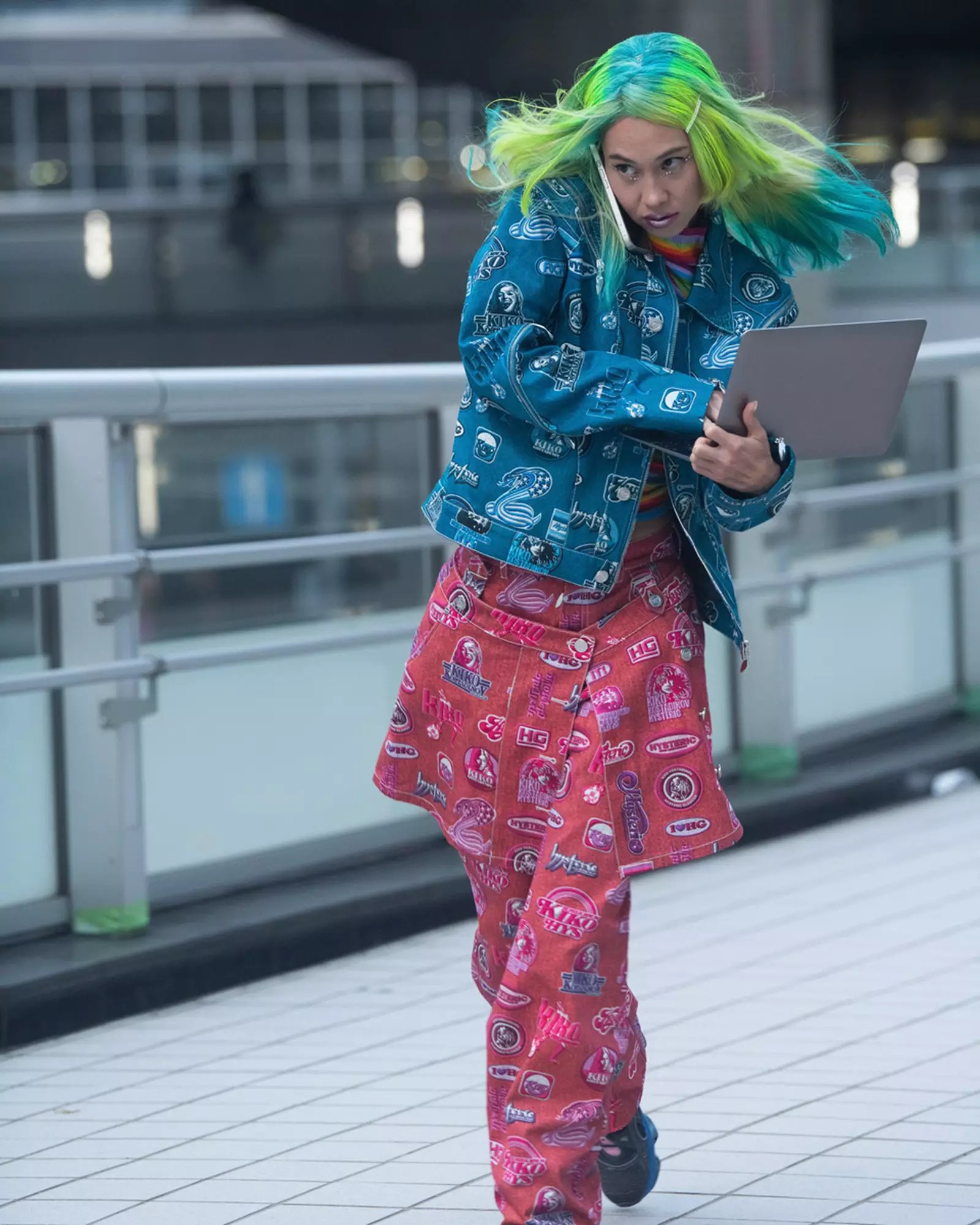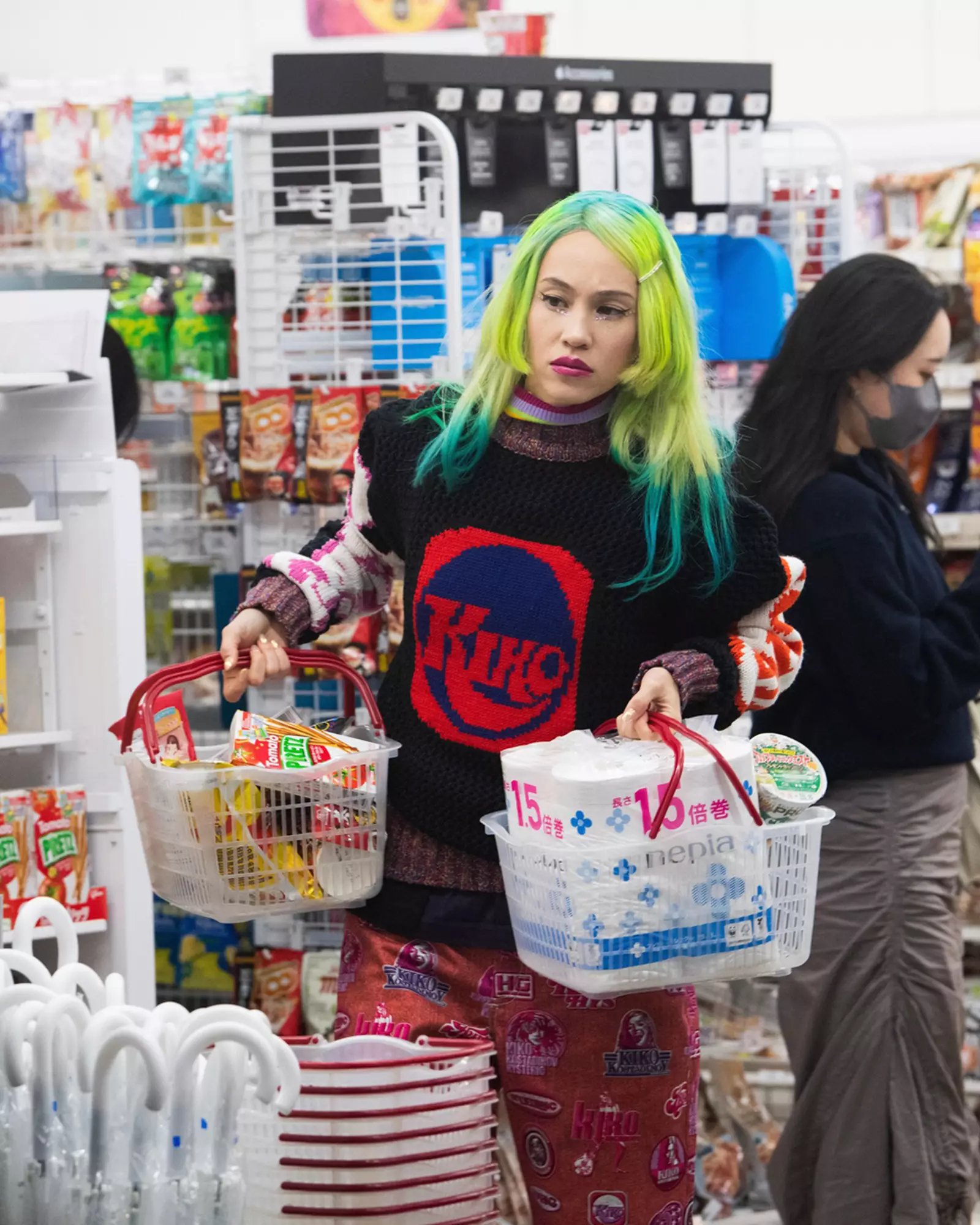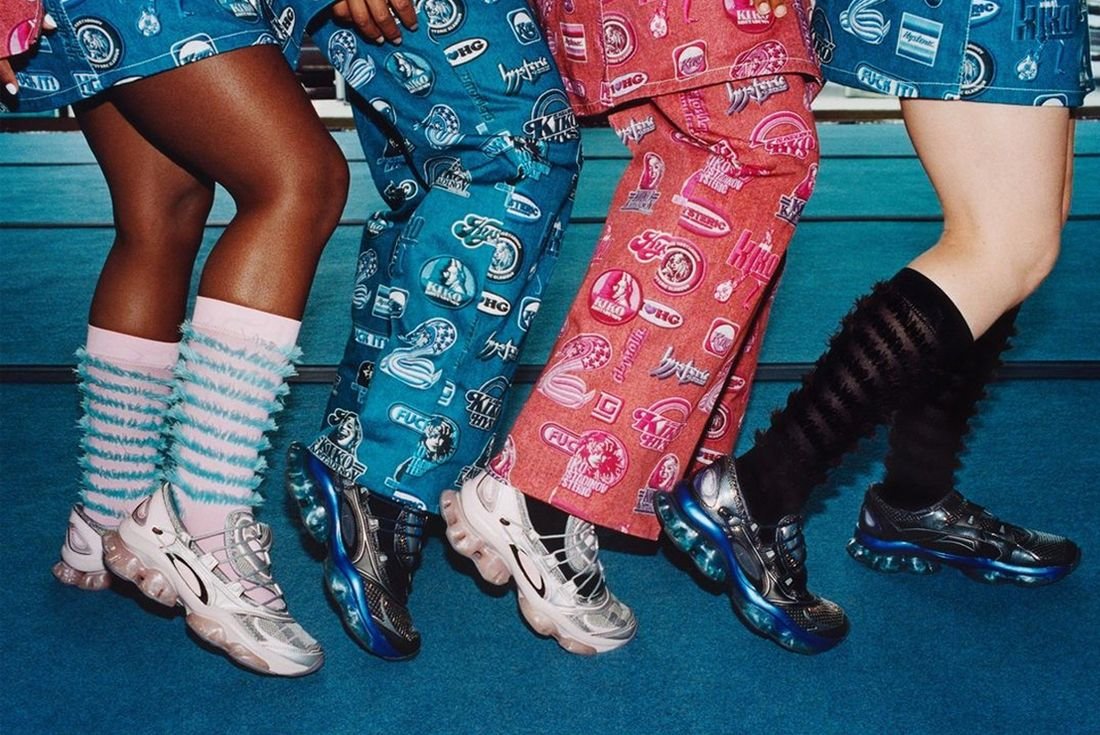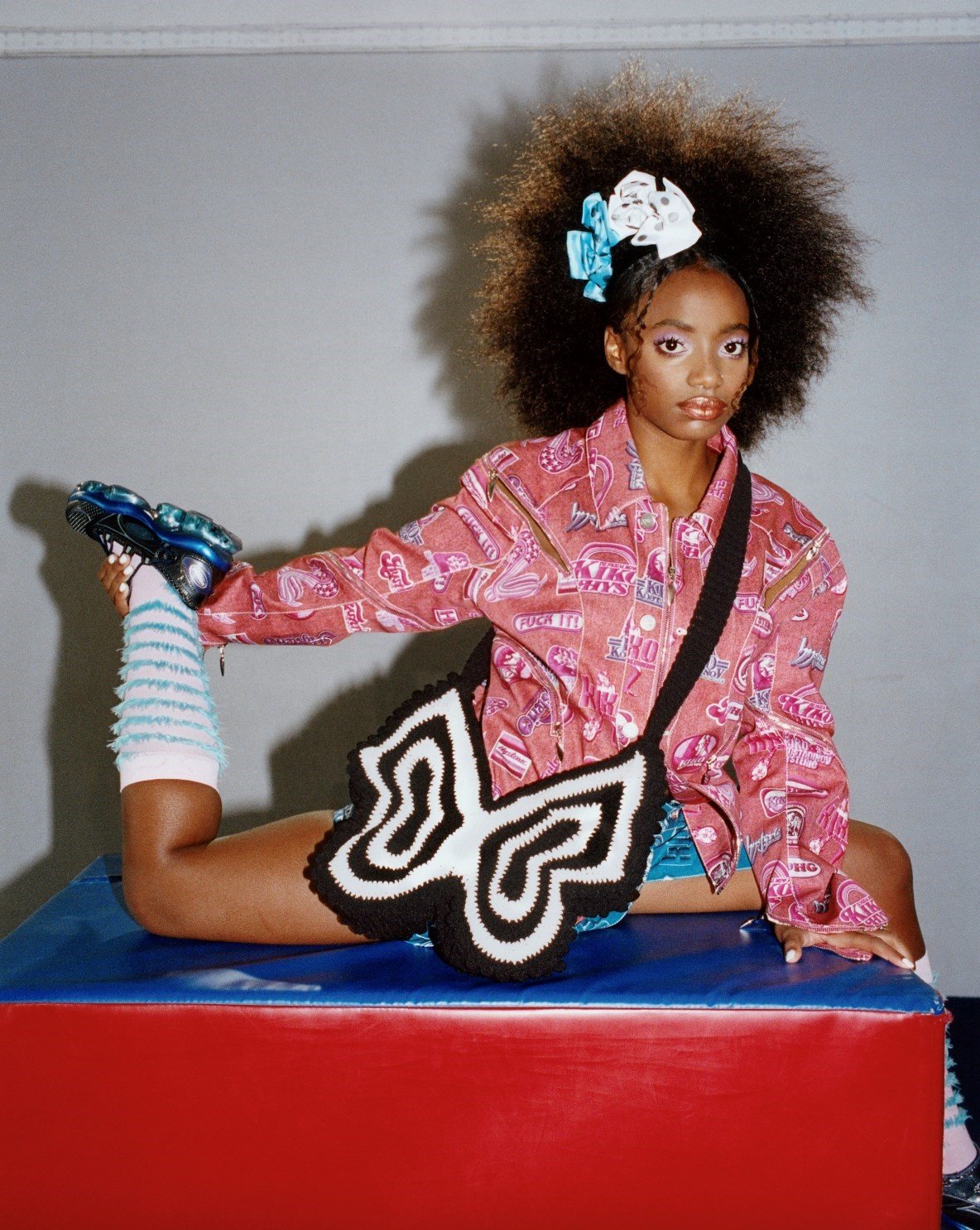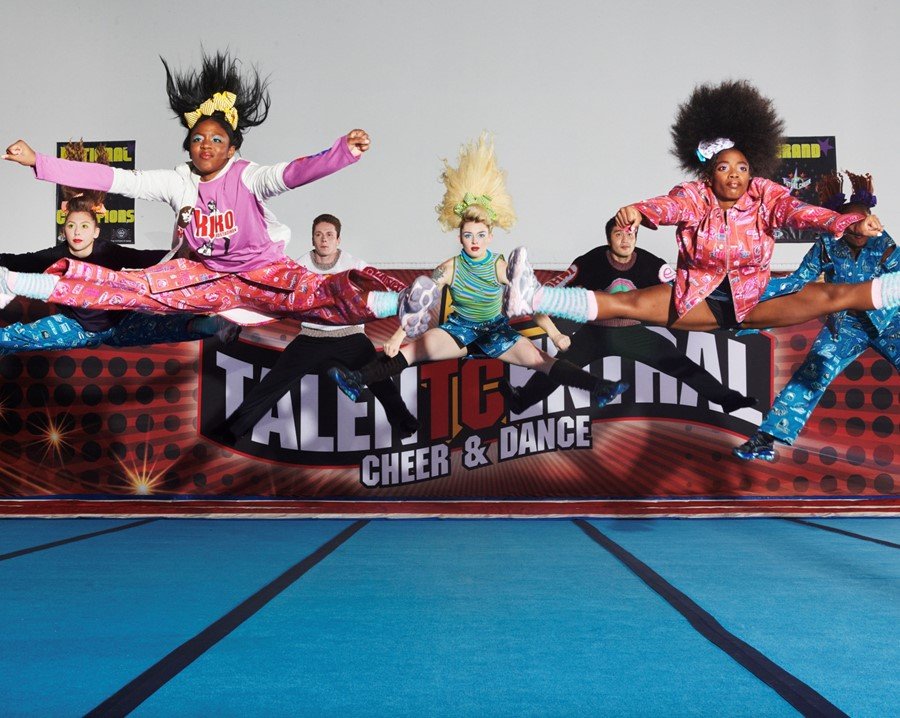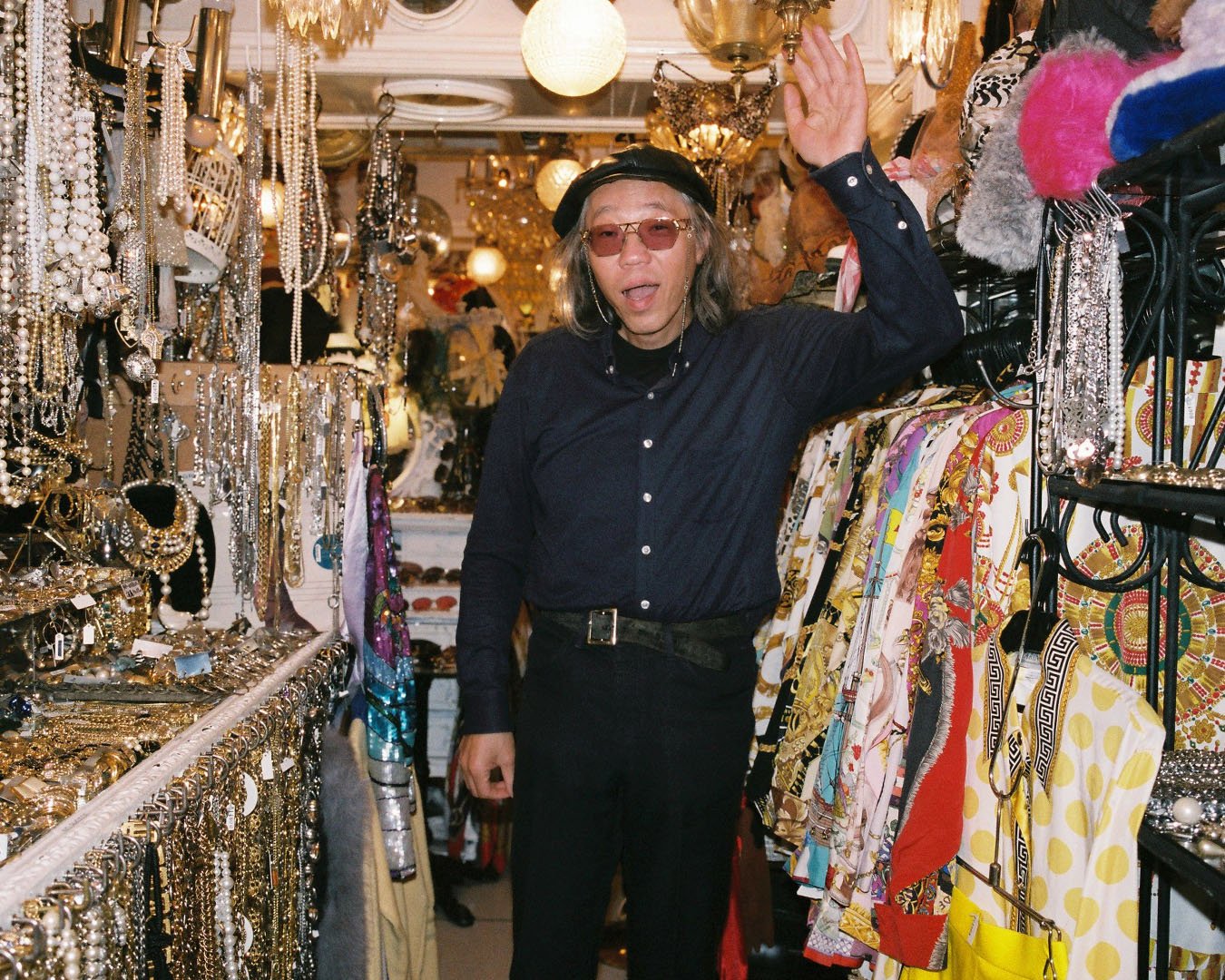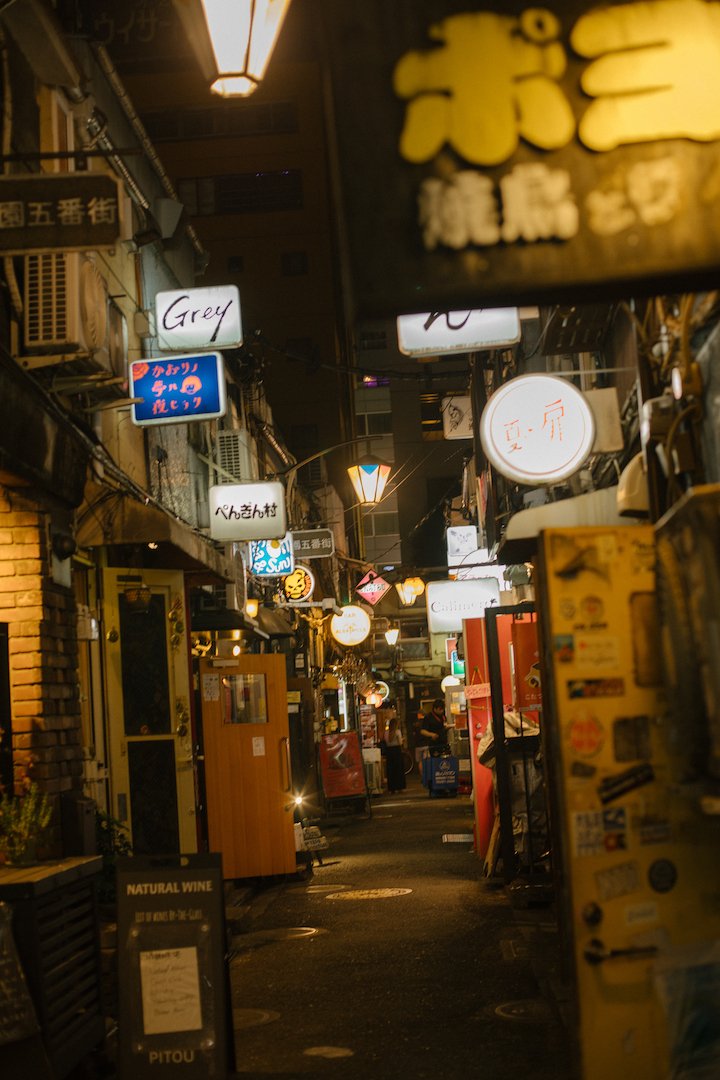HYSTERIC GLAMOUR Is Forever Cool: Nobuhiko Kitamura's Ura-Americana Style Legacy

Nobuhiko Kitamura doesn’t care about fashion, he cares about style.
Nobuhiko “Nobu” Kitamura in front of the HYSTERIC GLAMOUR store in Harajuku
This may seem like a shocking omission from the head designer of the cult classic label HYSTERIC GLAMOUR [Hys for short], but from day one, back in 1984 when his first collection instantly sold out with barely any promotion, Nobu has ignored passing trends and followed the simple goal to make “clothing his favorite rockstar would wear”.
Courtney Love wearing Hysteric as part of a Hysteric Glamour campaign
This mission 35 years later still strikes a chord with youth from London to Tokyo, who buy his latest collections and more recently search far and wide for coveted archival items on Mercari and select shops. Especially, in the wake of 90s/ Y2K revivalism that heavily takes notes from scans of street style fits from magazines like FRUiTS and Soen. Finding vintage Hys is a holy grail, it’s a sign of a certain form of cool, one that’s culturally literate and a mix of past and future.
Moving full circle, the fervor that vintage HYSTERIC is snatched up on second hand resale platforms mimics the way Nobu himself scoured thrift shops for retro pieces. The fact that he’s won the hearts of the very people he’d probably hang out with if he was a twenty something in 2023, isn’t lost on Nobu- it’s what gives him the drive to keep designing for the new generation obsessed with music, kitsch, and Americana.
HYSTERIC is by no means a new topic on sabu, but just to recap it’s the Ura-Harajuku take on Americana, an East meets West fusion of everything that we love. Taking iconography from 70s concert posters, B-grade movies, mass consumerism, and applying it to classic American staples like varsity jackets, military fatigues, trucker hats, and denim, mixed with bold colorways as well as Nobu’s signature tongue in cheek humor.
The enduring respect and cult status Hys has earned is partially because the label has stayed true to it’s music inspired roots,with a slew of collabs from musicians like Sonic Youth, MC5, and Iggy Pop, but also the fact that Nobu isn’t afraid to dip his toes into something new. Case in point: HYSTERIC’s collaboration with Perks and Mini in 2023, and it’s intensely sought after 2022 release with Kiko Kostadinov, blending Nobu’s penchant for Warhol-esque logos with Kiko’s touch of futurism. Hys has also done recurrent collabs Kim Gordon founded brand X-girl as well as Supreme, which paid particular homage to one of Nobu’s most popular designs, his instantly recognizable snake printed denim pieces. Nobu has also established his street style legacy by enlisting photographers Daido Moriyama and Nobuyoshi Araki in photo book projects incorporating the grit and unpredictability of youth culture amongst their glossy pages.
HYSTERIC X Perks and Mini collaboration shot by Joshua Gordon
The HYSTERIC GLAMOUR X KIKO KOSTADINOV campaign, chock full of retro futurism
Hysteric Glamour was part of the fashion innovation boom of the 80s-00s known as the Urahara era, when streetwear brands like BAPE and X-Large were arguably at their golden age of experimentation. Hysteric Glamour, although a part of this wave, was also a stand alone pioneer as a “New Americana” brand or Ura-Americana style label, not just recreating Western styles but infusing them with Japanese sensibilities. Pushing the boundaries of what women’s fashion could be, making it unabashedly raunchy, “unlady-like”, with “borrowed from the boys tailoring” by taking classic mens silhouettes and adapting them for womens sizing.
Although technically labelled womenswear, HYSTERIC was initially intended to be a unisex brand but officially expanded into menswear in 2001. The name itself, “Hysteric Glamour” Nobu chose while looking for words with no equivalent in Japanese, coming up with “Hysteric” and “Glamour” because they reminded him of his favorite rockstars Patti Smith and Debbie Harry, epitomizing the emotions he wanted his clothing to channel.
A club kid himself, Nobuhiko Kitamura was still a student at Tokyo Mode Gakuen [a Tokyo based fashion school], working multiple part time jobs including being an event planner to fuel his vintage and record buying habits, when he started designing for various Japanese brands freelance. Some of his initial designs were for Ozone Community, a cult brand in its own right, that saw Nobu’s potential from the get-go, offering him the chance to start his own brand with full creative freedom shortly after he graduated at 21 years old.
Nobu Kitamura circa the 00s
The risk of putting such a young creative with a rebellious streak at the helm of a label proved to be a good choice as Nobu quickly made bold decisions in his marketing strategies and the types of people he intended to wear his designs: outcasts, misfits, music lovers, the unapologetically underground.
HYSTERIC GLAMOUR’s development was rooted in youth culture from the very beginning, ignoring the desire to be a part of Paris’s high fashion scene that many Japanese brands aspired to at the time, turning its attention to Tokyo’s streets and club kids as their target audience.
Beyond 70s revivalism, Hys has found a niche in hip hop and hyper pop communities
sabukaru got the chance to dive deeper with Nobu about his influences, the early days of HYSTERIC, his thoughts about the future of youth culture, and why he’s happy vintage Hys is making a re-emergence. In Nobu’s words, he wants the new generation to “one day be digging for my vintage clothes. I just really want to see that happen.”
Nobu in the Hysteric Glamour office in Sendagaya
Can you briefly introduce yourself to THE SABUKARU NETWORK?
まず最初に簡単な自己紹介をお願いしてもよろしいですかよろしいですか?
I started this brand called HYSTERIC GLAMOUR in 1984,and I suppose it’s still alive and well [laughs].
1984年に HYSTERIC GLAMOUR っていうブランドを自分で始めたんですけども、まだ続けてこられるっていうのかな《笑》。
Nobu flipping through Hys graphic design archives, full of cult movie and pin up samples/references coupled with shock worthy slogans
It’s very impressive that you’ve managed to keep your brand alive for so long. Did you ever imagine you were going to realize a legacy of 40 years in fashion when you started out?
40年近くブランドを経営されてきた中で、当時からこれだけ長くヒステリックグラマーをやるマインドセットはあったんですか?
Not at all. I first got my start in the industry sketching designs for this brand called Ozone Community as a part time job. I suppose I left an impression on them so they recruited me to start a new brand as I was graduating college. I was about 21 years old so I took their offer half assed, telling myself I’d quit whenever I felt like it [laughs]. I wanted to go see places like London and New York at the time since I’ve never been, but it was an opportunity that presented itself unexpectedly, so I said fuck it and got to work.
全くないです。元々僕は学生の頃に一年半ぐらいオゾンコミュニティっていうブランドを経営してた会社でデザイン画を描くアルバイトしてたんですよ。そこで結構良い結果を残してたみたいで、僕が卒業するタイミングにそこの会社から「新しいブランドをやってみたいんだけど、お前やってみない?」みたいな事を言われて。丁度21歳だったんですけど、いつでも辞めていいかなあみたいな気持ちで始めちゃったんですよ《笑》。ニューヨークとかロンドンに留学じゃないけど行ってみたいって考えてた時でもあったんですけど、「せっかくのチャンスだからやってみよう」って思ってやり始めたのが1984年でしたね。
A timeline of Hysteric Glamour’s design development
Being in the industry for so long, what are the things that still excite you? What are the things that make you want to get up from bed each day?
40年近くファッション業界で働かれて、どういった事が毎朝ベッドから起き上がるモチベーションになってますか?
Nobu and friends
Firstly, music. I’ve always loved music and I started looking for jobs that had absolutely anything to do with music in high school. I even flirted with the idea of becoming a musician at one point but I had no musical talent whatsoever, so I decided to somehow get involved off the stage.
I started digging and listening to different artists, but mind you music was distributed through physical records with jackets and all and I got hooked on the cover art that decorated these records. I then got the idea of becoming a fashion designer, thinking that I might one day be able to collaborate with all the musicians I loved. That’s sort of how I illustrated my grand dream at the time.
I also worked part-time for this company that directed fashion shows, and I got to meet a few designers. I was cocky, but working and talking to these designers [even though I was just a student] I felt as though the very system that forced designers to run a show every 6 months bred ground for garments and designs to suffer.
So, I didn’t want any part of that. I always loved different subcultures whether it be music or film. I knew if I was going to pursue this path, I wanted to implement my love for these things in my designs.
Most of the Japanese designers at the time were dreaming of being part of the Paris collection, so they didn’t even bat an eye at what was going on in street culture. All these things led me to come up with HYSTERIC GLAMOUR’s concept: a brand closely tied to street culture, paying no mind to runway shows, indebted to subcultures like music and film.
一つは音楽。やっぱり音楽が好きで、高校時代は何か音楽に絡められる仕事はないか探してて。自分が楽器をやってたら自分でステージに立てたわけですけど、そういうセンスがなかったので聞く方に回ろうと思って。色んなミュージシャンを掘って聞いてたりしたんですけど、当時はレコードだったので、そういったもののジャケットのグラフィックなんかも好きで、そういう関係の仕事はないかと思ってた時に洋服のデザイナーとかになったらどこかで自分の憧れるミュージシャンと絡めるかもしれないと思ってて。最初はそういう風に夢を描いてたんですね。
それから学生の時にファッション・ショーの演出をディレクションしてる様な会社でアルバイトしてて、何人かデザイナーに会う機会があったんですよ。当時学生ながら生意気に、6ヶ月おきに行うファッション・ショーに備えて洋服をデザインするシステムに対して完成度が低くなっちゃうんじゃないかと思ってて。だからデザイナーになるんであればそういう風にはなりたくないと思って。中学生の頃から音楽とか映画だったり本にしても、サブカルチャーのものが好きで、自分の好きなものを取り入れた洋服のデザイをしたいと思う様になって。
当時はパリコレを目指すデザイナーがほとんどだったんですけど、ストリート・カルチャ―なんてそっちのけの状態で。それからファッション・ショーをやらないブランドのコンセプトを思いついて、ストリートの感じでありながら音楽とかヴィンテージなフィーリングを漂わせる様な洋服を作ろうと考えて。
Nobu examining a 90s era early Hys logo design created by Nobu himself
Graphics are A large part HYSTERIC GLAMOUR’s identity. Can you tell us a little bit about how you first started designing your own clothing’s graphics?
HYSTERIC GLAMOUR と言えばグラフィックの印象が強いと思うんですけど、洋服にグラフィック・デザインを取り入れようと思ったキッカケ、またグラフィックを好きになったキッカケについてお聞かせください。
It all started with music. I started to pay attention to the cover art on every record I saw and fell deeply in love. I also liked the package designs of Western products.
グラフィックを好きになったキッカケは音楽。レコードのジャケットのアートワークが好きで意識する様になったんですけど、アメリカのマスプロダクトのパッケージのデザインなんかも好きだった。
Do you still remember some older graphics you did for hYS that you still love?
HYSTERIC GLAMOUR でデザインされたグラフィックの中で特に好きなものってあったりしますか?
That’s a difficult question. I don’t know because each season's theme, and sometimes I choose a certain graphic to be put on a shirt and end up regretting it a few months down the line.
難しいですね。シーズン毎に違うテーマでグラフィックをデザインしてるんですけど、当時良かれと思って採用したデザインでさえ数か月後に後悔する事もあるので。
In the span of 40 years the tools used for graphic design have changed too. has there been any evolution in your process?
40年の間にグラフィックデザインの技術も進化していると思うんですけど、当時からのやり方を今も尚続けられているんですか?
I still use the xerox machine a lot. I dig through books and vintage magazines for the smallest details. So, I still do a lot of things by hand whether it's using the xerox machine or collaging. This is one of my favorites that I’ve made. Each detail I xerox, cut, and collage, but I wanted to create something that felt like a mandala. I think this is from 1987-1988? [points to a series of handmade designs from a thick paper folder]
未だにゼロックスで本だったり雑誌の細かいディテールをコピーしてるし、コラージュもみんな手作業が多い。これなんかは面白いんだけど、1987-1988年頃のやつかなあ?
Where do you source all the materials for collages like these?
こういったデザインの素材はどういったところから持ってくるんですか?
I had to dig secondhand and vintage bookstores. I’m always looking around Jimbocho, Tokyo but even when I do go to other countries, it’s the first place I visit.
東京だと神保町の古書店行ってあさる事が多いんだけど、海外なんかに行ってもまず古本屋寄るね。
What is your favorite store in Jimbocho?
神保町だと何処に行かれる事が多いですか?
KOMIYAMA TOKYO has a really good selection, but prices are fucking horrible. I know Keita Komiyama, the owner of the bookstore because I go there all the time, but I make sure he knows his prices are unbelievable in many ways.
小宮山書店は色々と面白いセレクションがあるんだけど、クソ高いよね。結構足運ぶからあそこの社長知ってるんだけど、行くたびに「-んたんとこのものは色んな意味でアンビリーバブルだよ」って言ってね。
Komiyama Tokyo in Jimbocho, a store famous for vintage movie posters, magazines, art books, and pretty much anything else a design nerd could ask for
It’s also worth noting, you started HYSTERIC GLAMOUR a bit before the Urahara movement. Can you tell us about what Harajuku was like during that moment, and what sort of brands existed back then?
所説によると1993年に裏原が始まったとされていますが、裏原以前から原宿で HYSTERIC GLAMOUR をやられてて、日本のストリート・カルチャ―の進化を目の当たりにしたと思います。当時のファッションや裏原以前のカルチャ―についてお話お聞かせください。
Michael Kopelman of GIMME FIVE actually came to Tokyo in the late 1980s and told me he wanted to bring HYSTERIC GLAMOUR to London. I was friends with this guy James Lebon and I had worked with him shooting a couple of videos, but he went back to London to record the soundtrack and Michael happened to be part of that project. He had just quit his job and started wholesaling Stüssy products and he was friends with the Soul II Soul members, who came and visited my shop when they came to Japan. They wore some of my pieces back in London, and they happened to have liked my clothes so much they started talking about it. By chance, Michael was there and that’s how he found out about my brand.
Michael was interested in making a trip to Tokyo and he finally got to visit with James when Stüssy first launched in Japan. They all visited Ura-hara and Hiroshi Fujiwara was also there, and I think that’s when all the craziness started happening. If I remember correctly, that was around 1989-1990.
丁度1980年後半にロンドンの GIMME FIVE の Michael Kopelman が東京に来て「HYSTERIC GLAMOUR をロンドンに持って行きたい」って言ってくれて。元々はマイケルの友人と僕が友達で、 彼と一緒に HYSTERIC GLAMOUR のビデオを撮ったんですね。James Lebon っていって、彼が映像のサウンドトラックを録音するためにロンドンに持って帰ったんですけど、その時にサウンドトラックの担当をしてくれたのがマイケルで。丁度その時脱サラして Stüssy の卸売をやってたりしてたんですけど、彼の仲間が Soul II Soul のメンバーだったりして来日した時にうちの店で買い物してくれて。それでロンドンで HYSTERIC GLAMOUR の服とかトラウザーを着てくれてて「なんでロンドンに HYSTERIC GLAMOUR がないの?」っていう話をしてた場にマイケルがいて、丁度ジェームスがサウンドトラックを録音してたみたいなタイミングが重なって。
マイケルも東京に興味を持ち始めた頃で、多分 Stüssy が日本に初上陸した時にジェームスとローニンレコード のアレックスと一緒に原宿に来て、そこに藤原ヒロシもいたんですけど。多分その辺から裏原の匂いがしてきたんですよね。1989〜1990年ぐらいのタイミングですかね。
How does it feel looking at fashion/street culture today, having shared moments with legendary figures like Michael Kopelman and of course being a legend yourself?
今やレジェンダリーとしか表せない HYSTERIC GLAMOUR や Stüssy のお陰で裏原や今のカルチャ―があると思うんですが、今も尚現役で活躍されてる当時をを代表するクリエイティブたちと交えた時間を思い返してみて思う事はありますか?
Japan had just started to become cool in the early 1980s, but even then we were seen as less developed compared to America or France. In the latter half of the 80s, when magazines like THE FACE and i-D started to pop off, the very people who made it cool, namely Judy Blame and Mark Lebon from BUFFALO started to show their faces around Tokyo. I think they were working with Takeo Kikuchi at the time, but some of them decided to stay in the city.
Nobu goes down memory lane, revisiting photos of him and his friends from the 90s
I was eager to learn English at the time, so I talked to a bunch of foreigners at different clubs I went to and got to meet them. I had also just started my brand, so I couldn’t leave the country, and I was thinking of how I could fast track learning English and I sort of came up with the idea of living with a native. I went out partying looking for someone who would be down to live together, and I met Marc Jacobs before he was Marc Jacobs, working as an assistant for this cameraman. He used to have long hair and partied around Nishi-Azabu.
Cell phones didn’t exist back then, so the club was sort of where people shared information. You had to be here on Monday, and there on Tuesday, and you had to be at those places to know what was going on. It was like how social media was before social media.
1980年代の頭はまだ日本ってアジア諸国の中でも唯一イケてるイメージはあったものの、アメリカとかパリに比べたら発展途上国に思われてたところがあるんですけど、1980年代後半になってロンドンで THE FACE とか i-D マガジンができた時に、そこでガッツリいい仕事をしてた BUFALLO のスタイリストの Judy Blame だとかフォトグラファーの Mark Lebon みたいな人たちがハイファッションとパンク・カルチャ―を交えながらガッツリやってた連中が東京に来始めてたんですよ。多分菊池武夫さんのお手伝いに来てたんだと思うんですけど、東京が面白くなってきて連中が東京に居座り始めたんですね。
僕は丁度その時に英語を覚えたかったんで彼らと仲良くなり始めたんですね。ブランド始めちゃったから外国にも行けない状態で、どうやって英語を勉強しようかなあと考えた先に「外人と住むしかないなあ」と思って。当時クラブでイケてる連中に声をかけて、そこから友達の輪が広がっていったというか。丁度 Marc Jacobs なんかもデザイナーになる前で、カメラマンのアシスタントみたいな事をやってて、当時はロン毛で西麻布とかで遊んでましたよ。
あの当時は誰も携帯なんか持ってなかった時代だから、夜クラブに行かないと話にならなかったんですよね。月曜日はどこそこ、火曜日はどこそこみたいな感じで行ってたんですけど、そういうところに行かないと情報が入って来なかったから、当時はクラブが SNS だった。
Can you tell us a little bit more about the club scene back then?
当時のクラブのシーンはどういったものでしたか?それぞれの場所でそれぞれのカルチャ―があって、それぞれの種族間さえあったと聞いています。
Clubs were everywhere from Nishi Azabu to Shibuya. Behind Aoyama or Roppongi, there were so many of them. In the 80s, it was mostly around Shibuya to Nishi Azabu. The Ebisu area was yet to have any. It was only in the 90s that places like Ebisu and Daikanyama started to pop off.
クラブはどこにでもありましたね。1980年代は大体場所が決まってて、その頃は恵比寿とかには広まってなくて。当時は渋谷から西麻布辺りにポツポツあった感じ。1990年代になってから恵比寿とか代官山にもでき始めてきたというか。
A Hys editorial heavy on the rock and punk influences from 2010
Where do you go when you want to listen to good music these days?
いい音楽を聞きたいとなったら最近はどういった所に行かれます?
There used to be this club called Heaven in Shinjuku. I think the owner is now managing this club called Bridge in Shibuya, but the one before had the best sound system. Otherwise, I think Contact and Vision that were in Dogenzaka are pretty cool if you wanted to just have fun. But if I really want to listen to music, I don’t know.
名前変わっちゃったけど新宿にあったヘヴン。今はそこのオーナーが渋谷のブリッジってとこをやってるんだと思うんだけど、サウンドシステムが凄いくて凄く狭い箱だし。後はやっぱ道玄坂近辺にあるコンタクトとかビジョンとか。コンタクトとビジョンの場合は音楽を聞きに行くというよりかは遊びに行くって感じで、もうちょっと真剣に音楽聞きたいなあと思ったらそこそこ良いサウンドシステムで聞いた方が気持ちいし。
We also saw that you used to DJ with Jun Takahashi. Can you tell us a little bit about that?
10年以上前に高橋盾さんとDJされてたと思うんですけど、少しお話お聞かせください。
The UNDERCOVER store in Aoyama used to be in a deeper part of the area, and NIGO had an A BATHING APE store just under it. But NIGO decided to move out, so Jonio came to me and asked if it was a good idea to open a small gallery space. I was working for UNDERCOVER designing some of their graphics, and we talked about music in our spare time, so I introduced him to German Progressive music, and he got instantaneously hooked. He was like,“these bands are insane!”and we started to dig deeper into German music. We were working together for UNDERCOVER and also started DJing together,so Jun suggested that we come up with a duo name,and I remember how my foreign friends used to say“amazing!” so I took that word and rearranged it.“ZAMIANG” just sounded right to me, and that’s how we came up with our duo name.
Nobu Kitamura and Jun Takahashi of UNDERCOVER, designers and friends who are also the occasional DJ duo known as ZAMIANG.
元々青山にある UNDERCOVER のお店がもうちょっと奥の方にあったんですよ。一階がアンダーカバーで地下が A BATHING APE かなんかだったと思うんだけど、二ゴーが出てって物件が空いちゃったからそこで「ちょっとパート活動的としてギャラリーみたいな事をやりたいんですけど」ってジョ二オに相談受けて。丁度その頃のアンダーカバーのパリコレかなんかのグラフィックを手伝ってて、それで音楽の話にもジョ二オが喰い付いてきて、好きだろうなあと思ってジャーマン・プログレッシブを勧めたら飛び付いてきて。「この音やばいっすねえ」とか言って、そこから二人で色々とドイツ系の音楽を探ってた時があって。それでとりあえず一緒にDJやったりとかグラフィック作ったりとかやるんで「チーム名決めましょうよ」って話になってて、名前を考えてたんだけど外人の友達と話してると「アメイジング!」とかって使うからアメイジングをアナグラムして ZAMIANG って良いかなあと思って。
You also have particularly good ear for new music, collaborating with the likes of rapper Duke of Harajuku and other musicians. Who are some of the artists you find exciting in Tokyo right now?
ヴィンテージに拘らず最近のアーティストにも興味を持ってコラボレーションされていると思うんですが、Duke of Harajuku 以外に面白いなあと思えるアーティストは他にいますか?
Koh and Duke of Harajuku, Tokyo rappers repping a HYSTERIC collab with VERDY
Kids from the Japanese Trap scene are pretty interesting. I was into Rock as a teenager, and most of my customers were from the this scene when I started HYSTERIC GLAMOUR.You have to understand back in the 90s, there was a clear line between Rock and Hip-hop, and having no real knowledge of Hip-hop history, I decided not to even bother venturing into that scene. It wasn’t until recently my friend had told me about the Japanese hip-hop scene that I started paying attention, and I just got hooked.
It was interesting because I discovered so much music and so many artists that blurred the lines across genres. In the 1960s The Beatles and The Rolling Stones caused a frenzy with Hard Rock and Blues Rock, which proceeded to launch the entire genre to the mainstream with the help of Led Zeppelin.
Punk culture was short lived but consequently spawned New Wave and DJ culture around the world, and led to the birth of mash-up music made famous by bands like Primal Scream. They may sound different from each other, but that‘s sort of the short history of rock music, right?
Hip-hop on the other hand may have started in the 1970s, but it’s already made a big impact, and it seems that kids in their 20s grew up listening to it, so it’s a part of their childhood. Whether from the radio or from their parents’ collection, hip-hop is their foundation no different from how rock was ours and as they’ve grown old enough to pick up instruments, they’re creating their interpretations of the classics.
It’s interesting because the current iteration of Japanese Hip-hop reminds me a lot of New Wave and Club music from back in the day. Throw in a little bit of ambient in there and it’s more than palatable. Moreover, it’s easier for these kids to make and publish their own music these days, compared to when Rock was in, where you not only had to get instruments but also be in one place to perform. The current iteration of Hip-hop music is unbelievably independent and I think there’s a lot of interesting things going on right now.
HYSTERIC GLAMOUR X VERDY
日本のトラップ系の音楽をやってる子たちは面白いなあと思いますね。僕元々ティーンエージャーの頃はロックがベースになってて、ヒステリックグラマーを始めた時も比較的ロック好きな人たちがお客さんに付いてたんだけど、まだ90年代だとロックとヒップホップではカルチャ―的にちょっと色が違う感じがあって。僕もあまりヒップホップの歴史とかアーティストを知らなかったからあえてヒップホップは遠慮してたというか、触れてこなかったんですけど、何年か前に友人が「今日本とヒップホップ系の子たちに面白い子いるよ」って言って何人か彼から教わったんですよ。そこから掘り始めたら面白くなって。「これもヒップホップなの?」っていうのがあったり。
1960年代に The Beatles とか The Rolling Stones が出てきてハードロックだったりブルース・ロックだの騒いで、それから1970年代に Led Zeppelin がロックをメインストリームに持っていった時にパンク・カルチャ―が出てきて、短く衰退してニューウェーブだったりDJ文化が入ってきて、ロックとクラブのサウンドを融合した Primal Scream が出てきたんだけど、それがロックじゃない?ビートルズとかレッドゼッペリンとは全く違う音楽をを作ってるんだけどロック。ヒップホップも1970年代後半に始まったとしても段々それが一周りしてって、今の20代の子たちなんかは産声挙げてるタイミングでラジオにヒップホップかかってると思うし、親なんかも聞いてただろうから彼らにとって一つのベースになってる。
それからヒップホップの中でもクラシックなものを子供の頃に聞いてるんだけど、今度自分たちで道具を持ってきて親の世代とは違う音を作りたいと思うだろうから、丁度今のトラップ系のアーティストの音楽を聞いてると1990年代のニューウェーブとクラブのサウンドとハイブリッド化された音に近いものがある感じがしてて。そこにアンビエントも入ってたりするから「これだったら全然聞けるじゃん」と思って。
ロックだとそれぞれみんな楽器を持ってどっかで集まってやんなきゃいけないけど、トラップの連中だったら機材があれば自分たちで音を作っていけるし、最終的にネット配信したりすれば凄くインデペンデントな動きをしてるわけじゃないですか。それなんかは面白いなあと思って。そんなところを色々チェックしてた時にサブカルに会ったのかな?うちの店で SKOLOCT のエグジビジョンをやってる時に Duke of Harajuku が来て、SKOLOCT の中野から彼を紹介されて。
“The Art of Rock [1987]” by Paul Grushkin seems like a pretty important book to you. Can you tell us a little bit more about why you relate to this book so much?
ノブさんにとって「The Art of Rock[1987]」はバイブル的存在と伺ってますが、詳しくお話お聞かせください。
The cover of The Art of Rock, a graphic design book that gave Nobu a crash course on the best of the best rock concert posters, album covers, and other band centric art
When I was just starting HYSTERIC GLAMOUR I was still working for designers by helping organize their runway shows, but the whole seasonality thing just didn’t click with me. As fate would have it, I came across two books that completely changed the trajectory of my career. One of them was this thick Dior book that archived all the different garments they made that I came across in this bookstore.
I was flipping through the book and realized that so many of the shots in the book were quite similar to how Rei Kawakubo and Yohji Yamamoto shot their campaign photographs in the 1980s. It was monochromatic and most of the silhouettes flowed like avant-garde garments, and it felt like Irving Penn and Nick Knight partnering with Yohji-san and Dior. It was only then that I realized how the very people at the top are susceptible to being influenced by other people’s work, and finally came to my senses.
The Art of Rock is a book that I discovered much earlier, after reading it I decided to make my own graphics from having that epiphany. The book itself contained a selection of record jacket artworks and posters from the 1960s~1980s, but it was the psychedelic posters that I was instantly drawn to. I knew I would be able to work for longer digging artworks and subculture artifacts than studying fashion history, and “The Art of Rock” helped me realize that.
丁度 HYSTERIC GLAMOUR を始めようとしてた時に、まだファッションショーのお手伝いとかしてたんだけど、デザイナーがテーマを半年に一回テーマを決めてやってる感じを見て嫌だなあと思って。そういう事をしばらくやってた時に本屋でたまたま結構厚い Dior のアーカイブ本と「The Art of Rock」っていう本に出会って。Dior の方は初代のものから色んなやつまでアーカイブで載ってて、その当時撮影してた写真が1980年代に川久保さんとか耀司さんがカタログで撮ってた写真にちょっと似てたんですよ。Irving Penn と Dior で組んだり Nick Knight と洋二さんが一緒にやってアバンギャルドなシルエットをモノクロの写真にするみたいな。それを見て耀司さんと川久保さんも過去のアーティストに影響を受ける事ってあるのかなあと思って「だったら俺は今の方じゃないな」って気付いて。
どちらかというと自分がずっと見てた「The Art of Rock」の中の作品を自分でやりたかったんで。「The Art of Rock」自体は1960年代~1980年代頃のレコードジャケットとかポスターをセレクトした本なんですけど、当時のサイケデリックなポスターだったりを見て自分の好きな世界を見つけて。それで自分はもうファッションの歴史的なものをディグるよりかはアートとかサブカルチャーの方を掘ってった方が長く続けていけるだろうなあという事に気付かされて。そのキッカケを作ってくれたのが「The Art of Rock」。
You chose the path less taken in fashion, even though you were already on track to making it in the industry. Would you advise this to younger kids that may be in a similar situation?
普通にファッションショーのお手伝いのお仕事を続けてればそのままファッション業界に居続ける事もありえた一方で自分のやりたい事を追及してきたノブさんですが、若い子たちにも同じ事をするよう勧められますか?
I want them to create things. Everything is digitalized now, but I want them to take photos and create photo books and have them feel the nuances of making something physical and digital. Back in my day, there was no such thing as the internet, so books and music were our source of information. We got inspired to make things from reading books and listening to music, and I think that cycle hasn’t changed seeing that kids are digging up things from our generation to get inspired.
Model Kiko Mizuhara a HYSTERIC GLAMOUR favorite, featured in many of the brands campaigns
So I want them to make things not to sell now, but rather to inspire the future generation 20~30 years from now. If you’re a musician make print CDs, and if you’re a visual artist make prints even if it means you can only make 100 of them. Who knows it might even end up in KOMIYAMA TOKYO for an absurd amount of money.
Technology improves each year, and the quality of data itself keeps on getting better, but I personally don’t want creativity to start and end in that closed environment.
Viewing data from 30 years ago with a monitor from the same year is different from viewing the same data with the newest monitor. Things erode over time, and that’s why vintage artifacts have value, and I don’t think this universal truth is going to change anytime soon. Kids these days are so talented, and I think they have so much in them in terms of creativity, but my only hope for them is to create things that go beyond the closed loop of data and technology.
やっぱりなにかものを作ってほしい。今の子たちは音楽なんかもデータで片づけられちゃったりとかしてて。良いビジュアルを作ってる子もいるんだけど、それが本になったりとかするとか、画像上では良い写真になっててもそれが印刷物になるとまた違うみたいなニュアンスも理解した上で何か残してほしい。僕らが1980年代のネットがなかった時に情報源となってたのはやっぱり本だったり音楽だったから、そういうものを手にして感じながら色んなものを見つけてインスパイアされるみたいな事をやってモノ造りをしてたから。
それで今になっては同年代に作ってた雑誌だとか写真集だったり服が若い子たちにネットを通して買われてインスパイアされるみたいなサイクルがあるわけじゃないですか。だから今売る為とかじゃなくて20~30年後の若い子たちの為にもっとフィジカルなものを残してほしい。音楽やってるんだったら CD とか、ビジュアルを作ってるんだったら印刷物を100部限定でもなんでもいいのよ。それこそ将来小宮山書店で凄く高い値で売られるかもしれないし。
マシンの性能が良くなってデータの質も年々良くなっていくんだろうけど、全てその中で終わっちゃうのは嫌だなあと思う。30年前のデータを30年前の機材で見るのと今の新しい機材で見るのではテンションが違うじゃない。やっぱり物って風化するから傷のないヴィンテージの本は高いし、ちょっと表紙が折れちゃってるやつは安いわけで、そういう物の価値観はいつの時代でもみんな好きだと思うんで。今の若い子たちも僕らが若い頃よりいい音楽を作ってると思うし、才能は溢れてる子たちもいっぱいいるから、僕はデータを終わっちゃうのは嫌だなあと思う。
You've long been a lover of all things vintage, but what do you think about the current resurgence of vintage and even used/second hand HYSTERIC’s popularity in Tokyo?
昔からヴィンテージだったり他とは違うものに目を光らせて集められていると思うんですけど、今東京で巻き起こっているヴィンテージブームについて思う事はあったりしますか?
I think it’s great that younger kids are digging up vintage stuff. Although I do have to say, back in the day all the good stuff like the Levi’s 501’s were all over the place and we were able to buy them for cheap, but in the last 30 years most of them have been dug up by the collectors. Ones that are in good condition can cost a fortune, and sneakers seem to be going through the same effect. In that sense, all the stuff we used to look for are either overpriced or hung up in a museum, so it’s interesting to think that all the stuff that we didn’t touch back then are considered grails these days.
An ad for Levi’s 501’s, an example of a vintage “grail”, a 21 year old Nobu would search for in vintage shops [especially ones circa the 70s], which now are mostly bought out by collectors and sold for much higher retail prices online
There used to be this vintage store called DEP-T STORE in Harajuku, all the people in Urahara from Jun to Hiroshi Fujiwara went there to shop. All the shops were managed by this guy called Seiji Nagai, and he used to buy clothes from America and curate them in his store.
Seiji-san used to take care of all of us. In the last 30 years his daughter Eri grew old enough to take over the business, and she decided to continue with managing vintage shops. She does all the buying and curating, and all the cool boys and girls around Shibuya and Aoyama come to shop there.
I remember sitting down with Seiji-san just watching how busy the store was that day, and he said, “I really don’t understand why Eri keeps on buying the stuff she buys. These are all the stuff I would never have bought back in the day, but they sell like hotcakes.” It hit me then that young people are eating up crumbs of what we took back in the day, but I also realized it’s also a matter of perspective. Although,we come from different generations with different tastes for things, in this small vintage-loving community, the eye that can distinguish tasteful to bland is important, especially when you’re managing a business.
ヴィンテージものをあさる若い子たちは凄くいいと思うね。僕らも同じ事やってたけど、その頃はまだ Levi's のダブルエックスみたいなヴィンテージ界隈でも絶品とされていたものが埋まってて、それが安く買えた時代なんだけど、ここ30年ぐらいで良いものはコレクターの元に行き届いちゃって。今だったらコンディションの良い Levi's だったら何百万円のしちゃうし、スニーカーなんかもそうなってきちゃったじゃない。だから僕らが探してたものっていうのは今の時代ではもうほとんどなくて、あってもミュージアムで展示されてるレベルみたいな。下手すると僕らが手を付けなかった1970~1980年代のものが今の宝探しの対象になってるわけじゃないですか。それはそれで逆に面白いかなあ。
今もうなくなっちゃったんだけど DEP-T STORE って原宿に凄く大きな古着屋があって、勿論ジョ二オにしろ藤原ヒロシなんかにしろ裏原で活動してた人間みんなを可愛がってた永井誠治さんっていう人が何店舗か仕切ってたんだけど、凄く面白い古着がいっぱいあって。それで永井さんもアメリカとかに行って服を仕入れてくるんだけども、自分たちでセレクトして持ってきてて。それから30年ぐらい経って娘さんも大きくなって、裏原にも DEP-T STORE ができて、もう一回古着屋をやるって事になったんだけど担当がお父さんじゃなくて娘さんになって。彼女が海外から色んなものを集めてきてて、それでやっぱりセンスのいい子だから渋谷と青山近辺の若いイケてる子たちがそこで買い物をしてる光景をお父さんと一緒に見てて。そしたら誠治さんが「エリの探してくる古着がよくわからんのよ。俺が当時絶対に手を出さなかったようなばっかりで。」って言いだして。そんなものしか残ってないんじゃないですかって話をした覚えがあるんだけども、やっぱり世代が違うと価値観も違うけど、ヴィンテージっていう偏りの中で良いものを見つけてくる目っていうのが多分その時代の若い子たちにとってみれば凄く刺激的なものになるかもしれないじゃないですか。
Dior’s design team was in Tokyo recently, and one of the designers who works closely with Kim Jones came to hunt down HYSTERIC GLAMOUR pieces. How does it make you feel hearing people like him looking for clothes you’ve made?
最近 Dior のデザインチームが東京に来てたんですけど、その一員がとにかくヴィンテージの HYSTERIC GLAMOUR のTシャツを探しまくってたそうで。今や若い世代にとってノブさんがデザインされたものは宝同然として扱われてる事についてはどう思ってますか?
I’m flattered. Back in 1984 I was still working for these Japanese designers who dreamed of making it to the Paris collection, but through that experience I got to learn a lot about myself and ultimately ended up where I am now. I felt happier digging through thrift stores and I loved the incomparable shock of finding grails, and I wanted for other people to share that experience even though it meant I was making clothes for kids from 10~20 years in the future. That’s how I envisioned HYSTERIC GLAMOUR as a brand back then, and hearing how the younger generations are starting to dig for my vintage pieces, I suppose one of my dreams has finally come true.
嬉しいですよ。1984年当時は僕も21歳でファッション誌に出てた Dior を見てパリコレに憧れてた日本人デザイナーたちの東京コレクションのファッションショーをお手伝いをしてたんだけど、その経験を通して自分とは違う方向性が見えたりとかして。僕も勿論色んなデザイナーの服を見てたんだけど、それよりかは古着屋でものを探したりして何か見つけた時の方が衝撃的に嬉しかったりしたから HYSTERIC GLAMOUR を最初にやり出した時に10~20年後違う世代の子が古着屋で自分が1984年に作ったものを見つけて同じ衝撃を感じてほしいと思ってて。そういうブランドになりたいなあと思って始めてるところがあるから、ここ数年になって要約若い世代の子たちが HYSTERIC GLAMOUR のヴィンテージをディぐってるって話を聞いた時には一個小さな夢が叶ったなあと思った。
Now that we’ve talked about everything vintage HYSTERIC GLAMOUR, let’s talk about what’s to come. Where are you taking the brand, having also started a sub-label, H.G.A.S.?
HYSTERIC GLAMOUR の40年近くに渡る歴史の中でサブ・レーベル H.G.A.S. をやられるのは初めてだと思うんですけど、少しお話お聞かせください。
H.G.A.S. isn’t so much of a brand but rather a space for the younger generation to flex their creativity. We have a lot of young staff and they have plenty of creative friends, so we host parties for them at our store and even open it up for exhibitions. I want to release students from the shackles of schools, and similarly salarymen from the shackles of workplaces. It almost feels like I’m the head of PTA for this project.
H.G.A.S. はブランドというよりもうちの若いスタッフとその子たちの仲間内に映像だったり音楽を作ってる子がいるんだけど、そういう子たちの為に場所を提供してる。渋谷のお店の二階にギャラリースペースもあるし、レディースのフロアも全部片付けてDJブースを出して一晩パーティみたいな事もやるし、学生を学校から、そして若手の社会人を職場から解放するみたいな感覚でやってる。だから自分の気持ち的には彼らのPTAみたいな感じかな。
What are you excited about and what’s to come for HYSTERIC GLAMOUR?
HYSTERIC GLAMOUR の今後を考えてエキサイトさせられるような事ってあったりしますか?
To be honest, I’ve been running HYSTERIC GLAMOUR for nearly 40 years, so it’s started to feel like an old brand to me. The fact that I am turning 60 years old made me think about retiring. That’s when the pandemic happened. Everything stopped for the last 2~3 years, and a bunch of my senior staff members decided to quit the company, but the younger ones were feeling restless looking for something to do. These kids sort of felt like they were similar to how I was back in the 1980s, since they were surrounded by technology growing up and developed a taste for things that were analog, so I decided to create a small team with them.
Having worked with them, it feels as though my passion and anticipation for what the brand could look like in the next 20~30 years reignited. I used to prepare myself for retiring at this age, but seeing how there are also plenty of 70-80 year olds kicking it, 60 feels like the start of my second career now. I’m grateful for the young staff that made me feel this way in the last few years, but in a weird way it feels like the pandemic couldn’t have started at a better time for me [laughs]. I’m not saying I’m glad the pandemic happened, but understanding that this happened and affected every single person on this planet, I couldn’t let it affect me negatively forever, you know?
The other thing is, I’m friends with Ryuhei Matsuda, and even though there’s a massive age gap between us, we enjoy going out for drinks and attending festivals like Fuji Rock. I’m actually about the same age as his mother Mikiko-san, but I hang out with him along with Jun Takahashi from time to time. Just recently, we all went to see MAHITO and GEZAN performing at Hibiya Open Air Concert Hall. Just before the concert, Ryuhei told me he just had his first-born, and decided to name him “Kotaro”. “Ko” also reads as tiger [according to the kanji used], and he mentioned that it’s because 2022 was the year of the tiger. Since I myself was born in the year of the tiger, I realized I was 5 cycles older than him.
What’s more this is the year of the water-tiger is special since it only happens once in 60 years. The famous Ieyasu Tokugawa was a “Mizunoe no Tora,” AKA a water tiger, but I started thinking about how the only “Mizunoe no Tora” I’ll ever meet are people my age or kids who were born this year like Kotaro unless I live until I’m 120 years old. That got me thinking, although it’s just my friend’s kid, the fact that we’re the same sign made me want to be alive and kicking until 80, so that Kotaro may one day be digging for my vintage clothes. I just really want to see that happen.
HYSTERIC GLAMOUR も1984年からやってるからあと二年もすれば40年やってる事になるから自分の中で古いブランドになりかけてる部分もあるし、僕ももう60歳だから「もう後10年ぐらいやるのが精一杯なのかなあ」みたいなリタイアの事を考える歳になってきてた。でもその時にコロナ禍になって全てがストップして。その2~3年間に色々と考えてたんだけど、うちの40~50代のベテランスタッフもそろそろって言って会社を離れて。その間にうちの若いスタッフは何かやりたくてうずいてたんだけど外にも行けない状態だったんだけど、1980年代に若かった僕らに少し似てる感覚を持ってる子たちで。生まれた頃からデジタルに囲まれて逆にアナログなものに興味が引かれる感性を持ってて、そういう子たちと新しいチームを作って。
それを始めてから20〜30年先の HYSTERIC GLAMOUR の変化への期待は初心に戻ってる。だから普通60歳っていうと還暦で「お疲れ様でした」って感じがするんだけど、ここ最近は元気の良い70~80代の人たちもいるし、そういう意味では二十歳が大人への入口だとすると60歳って第二の成人式みたいな感じがして。「もう60歳だし」ってなりかかってたところにここ2~3年で「うちの若い連中たちと面白い事できそうじゃん」っていう気持ちになれた事はコロナ禍もいいタイミングで来たなあみたいな《笑》。ネガティブに考えちゃうと「FUCK CORONA」なんですけど、世界的にみんな受けちゃったマイナス要素だから、逆にそれをプラスに変えて考えてった方がいいかなあっていう感じでいます。
後身近でいえば、年は離れてるんだけど一緒に飲みにとかフジロックに行ったりしてる役者の松田龍平が最近再婚して子供ができたんですね。龍平のお母さんの美由紀さんは僕より一個上なんだけどどっちかというと同世代なんですよ。それで彼女の倅と共通の友達にジュン・タカハシと飲みに行ったりバカ騒ぎしたしたりするんだけど、この間日比谷野音でマヒトゥがやってる GEZAN っていうバンドのライブにみんなで見に行って。
それでライブ前に龍平と子供が生まれたって話しをしてたら「名前は虎太郎」って言って、今年寅年で俺も60歳だから寅年なんだけど、虎太郎とは五周りも違う事に気付いて。ちょっとなんか他人事じゃなかったというか、今年の寅っって壬の寅っていって60年に一回の寅で徳川家康なんかがそうだったんだけど、僕が人生の中で壬の寅に合うのは同級生か今年生まれた子たちか僕が120歳まで生きないと次の壬の寅たちとは会えない。たかが友達の子供なんだけど、その子と60歳も離れてる同じ十二支のサインで、その子たちが二十歳になるには自分が80歳になるまで頑張んなくちゃいけないって思えて。虎太郎が20歳になっても自分の服が存在するのか、今作っている服のヴィンテージをあさってるのか、その光景を見てみたい。
We also saw your collaboration with Ibuki Sakai. sabukaru also had the chance to sit and talk with her, but can you tell us about how this project came to be?
最近 sabukaru でもインタビューさせて頂いたんですけど、Ibuki さんとのコラボレーションとそもそもどうやって繋がったのかについて少しお話をお聞かせください。
Ibuki Sakai, model and artist, a Hys fan and later a collaborator Nobu
We did an exhibition to complement the collaboration as well. I met her through a friend, but she and Kiko Mizuhara were part of the group that started digging vintage HYSTERIC GLAMOUR pieces about 7 years ago. It wasn’t so much of a thing back then, but Kiko told me about it, and I met Ibuki in a karaoke box when we all went out after having dinner with friends. We exchanged a few words, but I realized how similar our tastes were, so I invited her to visit the store, and the rest is history.
コラボと一緒に作品展も渋谷でやって。元々友達の紹介で知り合ったんだけど、丁度水原希子が7年前ぐらいに HYSTERIC GLAMOUR のヴィンテージを探し始めた時に Ibuki なんかも一緒のグループであさってて。その当時はまだ誰もあさってなかったんだけど「そんな子がいるんだよお」っていう話を聞いてて、たまたま友達とご飯食べた後にカラオケに行ったらそこに IBUKI も来てて。そこで初めて紹介されたんだけど、話してると共通の知り合いがいたりテイストが似てる事がわかったんで会社に遊びに来なよみたいな。
Ibuki in her room filled with HYSTERIC GLAMOUR
What about Ibuki’s style do you think fits so well with HYSTERIC GLAMOUR?
Ibuki さんのどういったところが HYSTERIC GLAMOUR とフィットすると思いますか?
I’m not sure, actually. I think our taste for junk is just really similar. But I also realized a relationship with her, where we both share information from our respective generations. I get to learn about new artists, and she gets to know about what really happened back in the day. She’s also about as old as being my daughter if I ever had one, but she’s not my actual daughter so we get to talk about these things.
なんでだろう。なんかジャンクなものの好き加減が似てるのかなあ。だけど世代が違うから彼女から情報をもらう。勿論僕から教えることもあるけど、IBUKI の世代が今どういう事に興味があるとか、彼女世代のマニアックなアーティストを紹介してもらったり、勉強になる。丁度年齢も自分の娘ぐらいなんでそういう意味で接する事ができる距離感なんだけど、本当の娘じゃないからこそこういう会話が成り立ってる。
A snapshot of Ibuki Sakai an artist and model, surrounded by her own sticker designs
We also admire how political you can get on your social media channels, which is quite rare among Japanese creatives. How important do you think it is to voice your opinions and perspectives?
ノブさんのインスタだったり SNS を通して政治的な話を結構させると思うんですけど、特に日本ではそういった話を避けて通る風潮がある中で積極的に発信する事に重要性を感じてたりしますか?
I think it’s important. People should be more aware of what happened in the past. Although figures like Ryoma Sakamoto and Takamori Saigo are treated like legends and consequently get more coverage, it’s important that we understand what happened during the Meiji Restoration, and what led to such an event to take place to begin with.
Youth movements that happened in the 1960s spawned different cultures that we consume as literature or even movies these days, and it’s easy to dismiss it just as that, but in fact it was so big that it left an imprint on human history.
The same thing could be said about Punk culture in the 1970s, where the youth revolted against society and popularized the anarchist ideology, but what’s important is that it was led by the youth. No different from the Meiji Restoration where the average age of the members was about 20 years old. It’s important to understand history not only to understand the context of what’s happening in Japan, but around the world in general.
大事だと思う。やっぱり歴史は知っておくべきだと思う。例えば日本の明治維新がなんでああいう事を起こしたのだとか、その明治維新の背景にどんな事があったのだとか。日本だと坂本龍馬とか西郷隆盛がヒーローだったり伝説扱いされて良く取り上げられるんだけど、実際にどんなクーデターが起きたのかとか、その背景にどういう事があったのかについて知ろうとする人たちがあんまりいない。だけど例えば1960年代に自分たちで学生運動を起こしてそこから違うカルチャ―が生まれて文学や映画になるんだけど、勿論その中には犯罪なんかもあるんだけど、やっぱりそういうものがあったからこそ凄く蠢いた時代もあるわけで。
1970年代のパンクカルチャ―にしても当時の社会の在り方に反対してアナーキズムみたいなのがあったりして、でもあれなんかもどちらかというとティーンエージャーのムーブメントだったわけじゃないですか。明治維新も同じで当時の人たちの平均年齢が20代で... 今日本に限らず世界で起こってる事を理解するには歴史を知る必要性がある。
You've been involved in fashion and collaborated with many of the legends for nearly 40 years now… but simply, what are some of the things you consider in including your outfits today?
40年ファッションに携わってきて色んな方々とお仕事される機会もあったと思うんですけど、最近のノブさんの私服を決めるポイントだったりはあったりしますか?
I wear the same thing every single day. From the shirt to the pants, and even my shoes, I own multiple pairs of the same clothes. I just really don’t want to think about what to wear when I start my day [laughs]. I’m in the business of making clothes, and I’ve come to realize how similar it is to farming.
We’re constantly reminded about the seasons [laughs]. So being a producer of said goods, I don’t want to waste any energy on what I’m personally wearing, and I’ve also been doing this long enough that I’ve established this outfit to be worn anywhere in any situation [laughs]. Manga characters don’t ever change their outfits, and that’s how people remember them, so I can’t just start wearing different outfits all of a sudden.
Also, dressing like a manga character for about 30 years has made it so that I don’t easily get fat nor thin. Overdrinking and overeating doesn’t affect my body so much, since I don’t ever want to wear anything other than my size, so my body naturally adjusts my habits to fit my outfit. You start having to worry about how healthy your innards are doing when you’re about 60, but I’ve personally had no issue in that regard.
毎日同じ服。服からパンツまで、それから靴も毎日同じ。全部うちのものですけど、同じ服を15着と同じトラウザーを3枚。やっぱり今日何着るかってあんまり考えたくない《笑》。さっきも同じ様な事言ったけど、音楽をやる側じゃなくて聞く側にまわったのと逆で洋服を着る側から作る側にまわっちゃったから、洋服って農業みたいなものでシーズンの事なんかもずっと考えてるから農家よ《笑》。だから自分が何を着るかって考えるよりかは無難な格好で。それで毎日同じ格好をしてるとどこへ行っても許される《笑》。
パーティに行っても「ノブさん来た」で済まされるというか、のび太なんかも同じ格好だし、漫画のキャラクターってみんな着替えないで同じ格好してるからみんなに覚えられていくわけだから。逆にたまに違う格好してたら「えっ!?」って言われちゃうだけだから。
30年ぐらい漫画のキャラクターみたいな私服してると得する事もあって、体系なんかはあんまり変わらなくなった。食べ過ぎても飲みすぎても毎日同じズボンと同じシャツ来てるから窮屈になりたくなくてあまり太ったりしない。60歳ぐらいになってくると血液の数値だとかで体系が物凄く影響されるんだけど、未だに検査しても全然大丈夫って言われるから。
Any last pieces of advice you might want to give to our young readers?
最後に読者に一言お願いします。
Thanks for the continued support [laughs]. I also want to say don’t be afraid to reach out through my social media channels. Times are different, and I’m open to meeting new people and potentially creating something together.
これからもよろしくって感じで《笑》。それからこういう時代なんでインスタとかを通しての出会いなんかは絶対あると思ってるし、そういうところからモノ造りに繋がる事もあると思うから、そこはオープンにやっていこうと考えてますので。
Interview by the sabukaru team
Interview transcription by Ken- born and raised in the Philippines, and is always looking to be amazed by cool people and things.
Written and edited by Ora Margolis
Article format by Ora Margolis
Photography by Natsuki Ludwig











